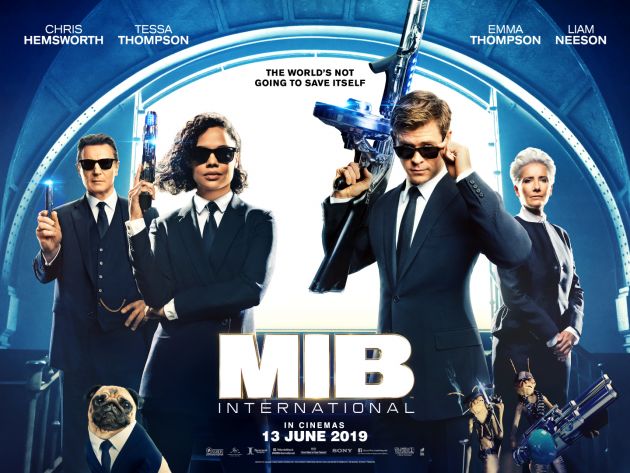
The fourth movie in the Men in Black franchise features the dynamic duo of Tessa Thompson (as a probationary Person in Black Agent M) and Chris Hemsworth (as Agent H). Thompson and Hensworth had great chemistry in Thor: Ragnarok and that on-screen chemistry only improves in Men in Black International. Emma Thompson, head of Men in Black (New York) sends Agent M to London where trouble is brewing. Agent M and Agent H team up when the alien they’re supposed to protect gets assassinated on their Watch. The plot thickens as Thompson and Hensworth follow the clues of a galactic scheme with diabolical aspects. Men in Black International is an old-fashioned Summer popcorn movie. I hope Thompson and Hemsworth team up again. GRADE: B
Author Archives: george
FRIDAY’S FORGOTTEN BOOKS #534: THE GOLDEN AGE OF SCIENCE FICTION: A JOURNEY INTO SPACE WITH 1950s RADIO, TV, FILMS, COMICS AND BOOKS By John Wade
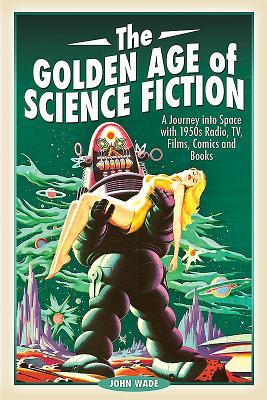
The Golden Age of Science Fiction according to John Wade is the 1950s. And this fun book makes the case for Wade’s beliefs with plenty of photos and artwork reproductions. Science Fiction had an impressive presence on the radio with programs like Journey Into Space and Operation Luna. If you don’t remember these radio programs, it might be because they were on the BBC. Wade grew up in England and The Golden Age of Science Fiction has a definite British skewing. Wade includes some wonderful graphics to capture the essence and feel of the radio programs.
Wade really hits his stride in his “Science Fiction on Television” chapter. He spends several pages on The Quatermass Experiment and its sequels. Wade praises the U.S. TV program Superman although he calls the robot in one of the episodes “unconvincing.” There was also Tom Corbett, Space Cadet.
As for SF movies, Godzilla showed up in 1954 and defined a new genre of Science Fiction. Forbidden Planet (1956) created a sensation with its Robby the Robot. The Day the Earth Stood Still (1951) had a different kind of robot and a different message. Wade also praises Destination Moon (1950)–based on Robert A. Heinlein’s Rocketship Galileo–for being as scientifically accurate as was possible in the 1950s. The movie that most affected me in the 1950s was War of the Worlds (1953). Wade includes the iconic movie poster in his presentation. Also discussed is the 3-D SF film, It Came From Outer Space (1953) (a movie I’ve never seen). Wade is also fond of This Island, Earth (1955). Perhaps the scariest SF movie of the 1950s was Invasion of the Body Snatchers (1956). I also remember seeing The Incredible Shrinking Man (1957) as a kid and loving it. Years later, I did see The Fly (1958). Wade even analyzes one of the worst movies ever made: Plan 9 From Outer Space (1959).
In the “Science Fiction in Books” chapter, John Wyndham–who wrote the classic The Day of the Triffids–leads off a series of 1950s writers like Isaac Asimov, Arthur C. Clarke, Ray Bradbury, Robert A. Heinlein, and Eric Frank Russell. I love the covers on the British paperbacks!
“Science Fiction Comics and Magazines” is the weakest chapter in the book. Wade writes about Astounding Science Fiction, Galaxy, and The Magazine of Fantasy and Science Fiction, but there were dozens of SF and fantasy magazines (some short-lived) in the 1950s. But, the cover reproductions are eye-popping!
If you’re a fan of Science Fiction, this book will take you on a delightful trip down Memory Lane! GRADE: B+
TABLE OF CONTENTS:
Introduction p. vii
Chapter 1 Science Fiction on Radio p. 1
Chapter 2 Science Fiction on Television p. 29
Chapter 3 Science Fiction on Film p. 57
Chapter 4 Science Fiction in Books p. 101
Chapter 5 Science Fiction Comics and Magazines p. 151
Picture Credits p. 200
Index p. 204
AMIDST THE CHAOS By Sara Bareilles

Generous Beth Fedyn sent me Amidst the Chaos by the talented Sara Bareilles. I think Katie saw Sara Bareilles on Broadway in Waitress. Sara Bareilles is a songwriter, singer, and actress. Amidst the Chaos reflects the whirlwind of activity in Bareilles’s life. These songs have clever lyrics and compelling melodies. I especially like “Fire” and “A Safe Place to Land” (featuring John Legend). You might remember that on April 6, 2019, Bareilles appeared as a musical guest on Saturday Night Live and performed “Fire” and “Saint Honesty.” If you’re in the mood for some excellent music, give Amidst the Chaos a listen. Thanks again, Beth! GRADE: A
TRACK LIST:
TITLE WRITER(S) TIME
1. “Fire” Sara Bareilles 3:50
2. “No Such Thing” Bareilles Justin Tranter 3:57
3. “Armor” Bareilles 4:27
4. “If I Can’t Have You” Bareilles Emily King Aaron Sterling 4:13
5. “Eyes on You” Bareilles 4:04
6. “Miss Simone” Bareilles Lori McKenna 4:13
7. “Wicked Love” Bareilles 4:39
8. “Orpheus” Bareilles 4:13
9. “Poetry by Dead Men” Bareilles Tranter 3:48
10. “Someone Who Loves Me” Bareilles 3:18
11. “Saint Honesty” Bareilles McKenna 4:35
12. “A Safe Place to Land” (featuring John Legend) Bareilles McKenna 4:29
ANCESTRAL NIGHT By Elizabeth Bear

I’ve read some early Elizabeth Bear SF novels and enjoyed them, but her new space opera, Ancestral Night, produced a lot of frustration. I found Ancestral Night full of riffs on democracy, artificial intelligence, and galactic history. Dull. The last 200 pages of this 512-page novel was a slow slog. If the blah-blah-blah was subtracted, Ancestral Night would be a 250-page novel…and a better book!
A salvage crew finds a strange alien starship in Deep Space. Then, they’re attacked by space pirates. The chase is on! But the action seems to happen in slow-motion with too much talk and not enough oomph! Not worth the effort. Elizabeth Bear will probably write some sequels to Ancestral Night, but I won’t be reading them. GRADE: C
ALL IS TRUE

All is True is an ironic title. You would be hard pressed to see Kenneth Braunagh under all the makeup that transforms him into William Shakespeare. And then there’s Shakespeare’s older wife (played by Judi Dench) with her smoldering resentments. Shakespeare’s family is dysfunctional and now that Shakespeare has “retired” he finds it hard to fix all the problems his absence in London shielded him from. I liked Shakespeare’s daughters, Susanna (Lydia Wilson) and Judith (Kathryn Wilder). I wish more of All is True dealt with their stories rather than with Shakespeare’s grieving.
The focus of All is True is Shakespeare’s dead son, Hamnet. Shakespeare feels guilty because he wasn’t home when his son died. Shakespeare was riding home from London, but arrived too late for the funeral. Years have passed, but Shakespeare’s guilt has festered. The Earl of Southampton (Ian McKellen) visits Shakespeare and the movie provides a strong vote that Shakespeare’s Sonnets were addressed to the Earl. But that’s just a diversion from the real story of this movie.
Despite the excellent cast, I found All is True a bit of a bore. The movie moves at a glacial pace and doesn’t know when to end. Do you have a favorite work of Shakespeare? GRADE: C+
BEST SELLER: A CENTURY OF AMERICA’S FAVORITE BOOKS By Robert McParland


Robert McParland’s Best Seller provides a history of American best selling books during the last century. McParland moves from year to year identifying trends and commenting on key writers. McParland uses publishing and literary history to define what makes a book a best-seller and what best-sellers say about reading American tastes and societal changes. Despite all the research, I found McParland’s analysis is clear and concise. He presents the historical context for each year, describes the best-sellers and the reasons for their appeal. In addition, McParland supplies descriptions of the authors. From classic literary works to pulp fiction, from historical blockbusters to trendy diet books, McParland’s tour of 118 years of best sellers is a delight! GRADE: A
TABLE OF CONTENTS:
Acknowledgments vii
Introduction: Reaching the Top of the Shelf: Discovering a Century of Bestsellers ix
Chapter One: Birth of the Bestseller: 1890s thru the 1930s 1
Chapter Two: 1940s: All the Books Fit to Sell 23
Chapter Three: 1950s: Cold War Anxiety: From Holden Caulfield to James Bond 53
Chapter Four: 1960s: New Frontiers: From Harper Lee to Kurt Vonnegut 83
Chapter Five: 1970s: The Age of Narcissism 109
Chapter Six: 1980s: The Rise of the Superstar Author 139
Chapter Seven: 1990s: Means of Ascent: Publisher Consolidation, Superstores, and the Internet 171
Chapter Eight: 2000s: E-Books and the New Millennium 211
Chapter Nine: 2010s: James Patterson, Inc. and The Soul of America 241
Notes 275
Bibliography 287
Index 293
About the Author 307
HAPPY 70TH BIRTHDAY TO ME!
DARK PHOENIX [3-D]
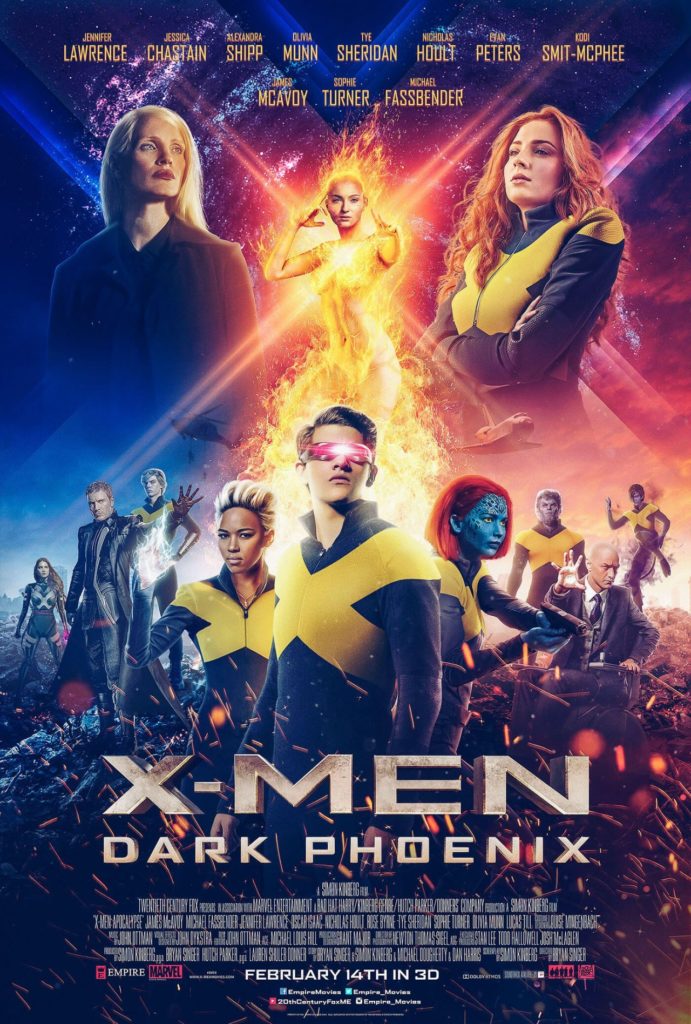
The “Dark Phoenix” is an incredibly powerful mutant called Jean Grey (played by Sophie Turner). Dark Phoenix traces the journey of Jean Grey from an 8-year-old-girl with strong but unreliable telepathic and telekinetic abilities. After a tragedy, Jean Grey decides to attend a school for mutant children run by Charles Xavier (James McAvoy). Then the movie fast-forwards 17 years to a daring rescue of the Space Shuttle when Jean Grey is needed to hold the disintegrating shuttle together. During the rescue, Jean Grey absorbs a cloud of strange cosmic energy that increases her powers geometrically. Of course, what would an X-Men movie be without some Bad Guys. In this case, it’s a band of eerie aliens led by Jessica Chastain who appears indestructible and plans to conquer the Earth. Given that Dark Phoenix is the last of the 21th Century Fox series (Disney now owns the rights to the X-Men franchise), Magneto (played by Michael Fassbender) had to show up to amp up the battle scenes.
My favorite X-Men movie character, the roguish Quicksilver (played brilliantly by Evan Peters), only appears in a couple cameos. Big mistake. Too much of Dark Phoenix is dark and turgid. The wit, humor, and speed of Quicksliver could have lighted the mood and added needed excitement. GRADE: B-
FRIDAY’S FORGOTTEN BOOKS #532: LITERARY SWORDSMEN AND SORCERERS: THE MAKERS OF HEROIC FANTASY By L. Sprague de Camp
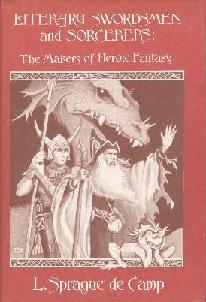
Just by chance, I stumbled across this 1976 Arkham House edition of L. Sprague de Camp’s wonderful Literary Swordsman and Socerers at my local public library. I immediately took it out and read it. De Camp’s informational essays on these fantasy writers made me want to drop everything and reread some of the great books by these authors. I’m a big fan of Lord Dunsany, but I haven’t read more than a fraction of his oeuvre. I’ve read most of Lovecraft, but I can always pick up one of his collections and find delight in its pages.
I’ve read all of Robert E. Howard’s CONAN tales, but Howard wrote a lot of other stuff that I haven’t read yet. I have the Night Shade Books editions of Clark Ashton Smith’s short stories, but I haven’t read them all. I’ve read Tolkien’s Lord of the Rings trilogy, but little else by this fantasy giant. I have books by Morris, Eddison, and White on my shelves, but I haven’t opened them yet.
De Camp’s essays display a familiarity with the works of all these writers. My only quibble is that Fritz Leiber–who wrote the marvelous Fafhrd and the Gray Mouser tales–only gets a few pages in “Conan’s Compeers” instead of an entire chapter which he deserves. The same for C. L. Moore who wrote the underrated Jirel of Joiry. Inexpensive reprints of LITERARY SWORDSMEN AND SORCERERS can be found online for reasonable prices. If you love heroic fantasy, you’ll love this book! GRADE: A
TABLE OF CONTENTS:
“Introduction: Neomythology”, by Lin Carter xi
Chapter I. “The Swords of Faërie” 9
Chapter II “Jack of All Arts: William Morris” 31
Chapter III. “Two Men in One: Lord Dunsany” 48
Chapter IV. “Eldritch Yankee Gentleman: H. P. Lovecraft” 64
Chapter V. “Superman in a Bowler: E.R. Eddison” 114
Chapter VI. “The Miscast Barbarian: Robert E. Howard” 135
Chapter VII. “Parallel Worlds: Fletcher Pratt” 178
Chapter VIII. “Sierran Shaman: Clark Ashton Smith” 195
Chapter IX. “Merlin in Tweeds: J.R.R. Tolkien” 215
Chapter X. “The Architect of Camelot: T.H. White” 252
Chapter XI. “Conan’s Compeers” 270
Notes 291
Index 303
CONAN’S WORLD AND ROBERT E. HOWARD By Darrell Schweitzer
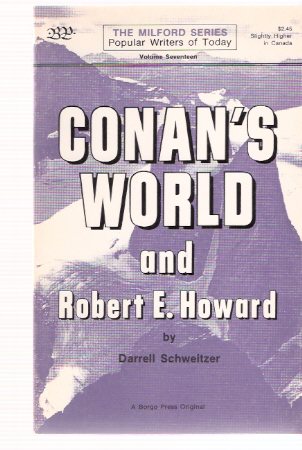
Just by chance I found this slim copy of Darrell Schweitzer’s Borgo Press paperback, Conan’s World and Robert E. Howard. Published in 1978, Schweitzer discusses each of the Conan stories Robert E. Howard wrote. This 64-page gem delivers information and appreciation about one of greatest sword and sorcery heroes ever. If you’re a fan of Conan and Robert E. Howard, you’ll enjoy this appreciation for Howard’s work and the character he created. Are you a Conan fan? Do you have a favorite story? GRADE: A


